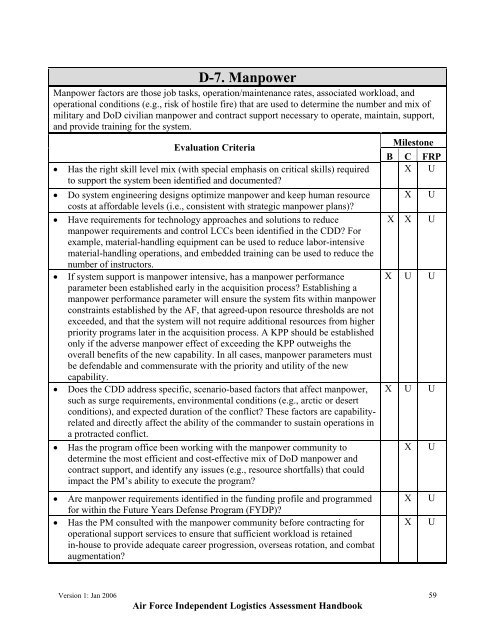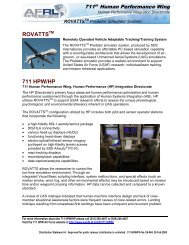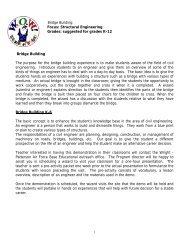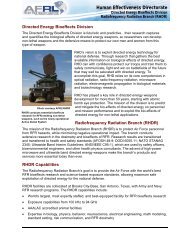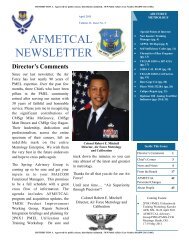USAF ILA Handbook - ACC Practice Center - Defense Acquisition ...
USAF ILA Handbook - ACC Practice Center - Defense Acquisition ...
USAF ILA Handbook - ACC Practice Center - Defense Acquisition ...
Create successful ePaper yourself
Turn your PDF publications into a flip-book with our unique Google optimized e-Paper software.
D-7. Manpower<br />
Manpower factors are those job tasks, operation/maintenance rates, associated workload, and<br />
operational conditions (e.g., risk of hostile fire) that are used to determine the number and mix of<br />
military and DoD civilian manpower and contract support necessary to operate, maintain, support,<br />
and provide training for the system.<br />
Evaluation Criteria<br />
• Has the right skill level mix (with special emphasis on critical skills) required<br />
to support the system been identified and documented<br />
• Do system engineering designs optimize manpower and keep human resource<br />
costs at affordable levels (i.e., consistent with strategic manpower plans)<br />
• Have requirements for technology approaches and solutions to reduce<br />
manpower requirements and control LCCs been identified in the CDD For<br />
example, material-handling equipment can be used to reduce labor-intensive<br />
material-handling operations, and embedded training can be used to reduce the<br />
number of instructors.<br />
• If system support is manpower intensive, has a manpower performance<br />
parameter been established early in the acquisition process Establishing a<br />
manpower performance parameter will ensure the system fits within manpower<br />
constraints established by the AF, that agreed-upon resource thresholds are not<br />
exceeded, and that the system will not require additional resources from higher<br />
priority programs later in the acquisition process. A KPP should be established<br />
only if the adverse manpower effect of exceeding the KPP outweighs the<br />
overall benefits of the new capability. In all cases, manpower parameters must<br />
be defendable and commensurate with the priority and utility of the new<br />
capability.<br />
• Does the CDD address specific, scenario-based factors that affect manpower,<br />
such as surge requirements, environmental conditions (e.g., arctic or desert<br />
conditions), and expected duration of the conflict These factors are capabilityrelated<br />
and directly affect the ability of the commander to sustain operations in<br />
a protracted conflict.<br />
• Has the program office been working with the manpower community to<br />
determine the most efficient and cost-effective mix of DoD manpower and<br />
contract support, and identify any issues (e.g., resource shortfalls) that could<br />
impact the PM’s ability to execute the program<br />
• Are manpower requirements identified in the funding profile and programmed<br />
for within the Future Years <strong>Defense</strong> Program (FYDP)<br />
• Has the PM consulted with the manpower community before contracting for<br />
operational support services to ensure that sufficient workload is retained<br />
in-house to provide adequate career progression, overseas rotation, and combat<br />
augmentation<br />
Milestone<br />
B C FRP<br />
X U<br />
X<br />
U<br />
X X U<br />
X U U<br />
X U U<br />
X<br />
X<br />
X<br />
U<br />
U<br />
U<br />
Version 1: Jan 2006 59<br />
Air Force Independent Logistics Assessment <strong>Handbook</strong>


